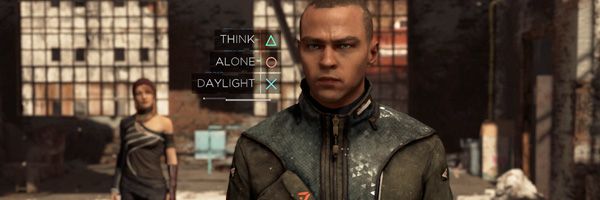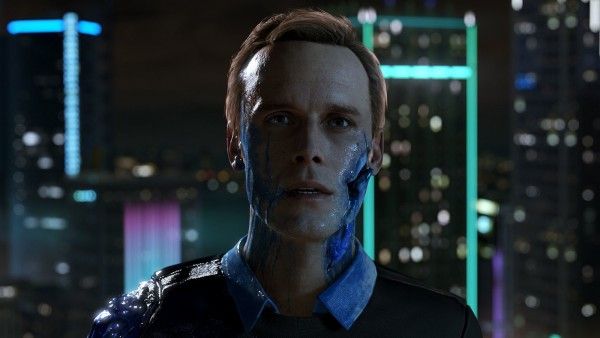After the success Quantic Dream had in 2010 with their BAFTA-winning game, Heavy Rain, plans began for a new cinematic gaming experience. In 2012, a casting session was held in Los Angeles for the role of Kara, an android with more humanity then her creators would prefer. A then 25 year old Valorie Curry was cast to portray the android for an E3 tech demo that would later become the 2018 PS4 exclusive, Detroit: Become Human.
The game follows three androids created by the company Cyberlife as they wade through the political and social minefield of futuristic Detroit in which androids are put to work as laborers, caretakers, and even officers. But something is changing in the androids. Some are becoming violent, some defiant, and some act out of self-preservation. Some even act out of love. It is almost as though they begin to develop emotions. The ones that show signs of straying from their code are known as Deviants. You play as Conner, Kara, and Markus. Each of their trajectories explore a different facet of android human relations, and you as a player have to decide how each will handle the world they are presented. Quantic Dream undertook an ambitious challenge to pull off a narrative experience with more branches, variance, and choice than ever before, but did they pull it off?
With most other “Choose your own adventure” games we’ve seen in the past, the paths have been rather predictable. Either your poor decisions simply make for less allies in a final battle or your choices are made almost irrelevant to the climax by some world changing revelation. Even Quantic Dream’s 2013 game Beyond: Two Souls had a rather forced final set piece regardless of the choices a player had made. Detroit: Become Human however has true variation (or deviation). Each character has entire scenes and set pieces that a player may not see depending on their playthrough. The choices made do not only affect your success or failure, but also your goals and motivations, and the choices of one character affect the options of the other two. The experience is most rewarding if you establish in your mind early on what you want each character motivations to be. From their the narrative and beautifully rendered world unfolds around you as you play.
Graphically this is a true marvel of what current consoles are capable of. On the PS4 Pro especially, this felt like watching a Hollywood film, and the inclusion of recognizable faces like Clancy Brown, Jessie Williams, and Minka Kelly doesn’t hurt. A large portion of the game gives you time to really soak in the surroundings, and the cut-scenes are all expertly choreographed. There is real thought behind the camera and shot choices of each narrative. For instance, Markus’ scenes play out with a more action-oriented, hand-held style as he leads a revolution from the front lines, while Connor’s view of the same scene is calculated and measured with smooth camera interaction. Without going into spoilers, the most impressive visuals for me were found in a place called Jericho.
Gameplay-wise, this is not a fast-twitch shooter. Characters walk slowly which gives you time to look at the surroundings but during timed interactions or backtracking, it can get annoying. A lot of things in the environment use the right joystick for interaction which is also your camera control, so you’ll occasionally find yourself spinning the camera away from the door you want to open. On “Easy Mode” the quick time events seem limited to only a few buttons, but in “Experienced Mode”, you’ll be using regular buttons, joystick input, triggers, bumpers, and even accelerometer controls. There are also quite a few times where the characters can hit invisible walls and barriers but this is dealt with in a clever way as it’s often part of the androids programming not to go down those paths.
The narrative is where the game really shines. Detroit: Become Human manages to tell not one, but three compelling tales of an androids struggle with the nature of its own existence. In truth Quantic Dream has been even more successful than that as they have given such fleshed out paths that each character can take. With a character like Connor, the android designed to hunt down deviant androids, you can stay true to your task, or you can begin to question your mission and maybe even join the rebellion. As widely diverse and all encompassing as this branching narrative structure is, there are a few gaps in logic that force you to certain conclusions, but for most characters this makes sense narratively as its their free will (the player) fighting with their programming (the game).
As someone who has played the game enough to have seen two completely different endings for each character. Here are my recommendations for a new player.
- Pick something simple you want each character to focus on. In times of tough decisions, this will help you stay true to your story.
- Be ready for the accelerometer controls. At first they're used for simple things like pouring juice, but when they pop up on combat is when it gets tricky.
- Exit often. One of the most unnerving things about the narrative is the progression of the android in the main menu.
- Don’t restart. If you mess up, live with the consequences for one playthrough. You can go back to any checkpoint and play again for a different result.
With a stellar narrative, amazing visuals, and a masterful cast, a few control input issues are not enough to knock this game off its well deserved pedestal.
Rating: A-




